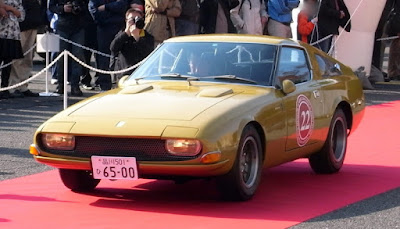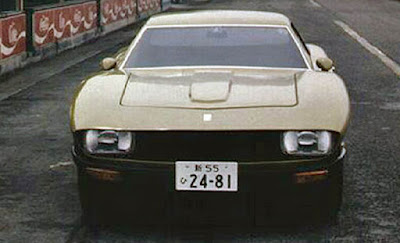Rare ONES - In the realm of automotive allure, the internet serves as a tempting den for enthusiasts. Subscribed to various feeds, we strive to break free from the notion that modern cars are mere commodities. Occasionally, we stumble upon a vehicle that is unfamiliar but captivates our attention.
 |
| The 1970 Carrozzeria Watanabe Griffon specimen being identified as No. 1. (Picture from: Automobiles Japonaises) |
The significance of a car's name extends beyond mere identification; it serves multiple purposes, from commercial branding to conveying the essence of the vehicle. Interestingly, a name intended for a singular car may find itself mirrored elsewhere, creating automotive doppelgangers.
 |
| The Griffon, initially named Flying Pegasus for serial production, was crafted by Carrozzeria Watanabe from 1970 to 1984, built upon the foundation of the Honda S600. (Picture from: Automobiles Japonaises) |
Consider the Griffon, a name borrowed from a legendary mythological creature with the body of a lion and the head and wings of an eagle. As discussed earlier, this name graces a sports car from Brazil, designed by Dawilson Lucato and Mario Belatto Jr.
 |
| The 1970 Carrozzeria Watanabe Griffon powered by S600's 606 cc 4 cylinder engine, generating 57 bhp at a thrilling 8,500 rpm. (Picture from: Automobiles Japonaises) |
Surprisingly, the Griffon's existence is not confined to Brazil alone. In Japan, a recent discovery introduces us to the Carrozzeria Watanabe Griffon. The 60s witnessed a motorsport frenzy in Japan, prompting the emergence of a domestic industry catering to the demand for speed.
 |
| One of the Carrozzeria Watanabe Griffons took on a role in the 1974 Japanese TV series 'Dengeki!! Strada 5.' (Picture from: IMCDB.org) |
Masao Watanabe, a wizard in setting up Formula 3 cars, transitioned to crafting his own road/race cars from 1970 to 1984. Subsequently, the company evolved into an alloy wheel/rim manufacturer, maintaining its vitality. The inaugural road car, initially named Flying Pegasus and later rebranded as Griffon for serial production, was based on the Honda S600. However, the term "serial" is loosely applied, as fewer than 10 units were ever produced.
 |
| The 1970 Carrozzeria Watanabe Griffon showcased improved aerodynamics, enabling it to reach speeds exceeding 160 kph—modest by contemporary supercar standards, yet its exoticism and aesthetics remain timeless. (Picture from: Automobiles Japonaises) |
Powered by the S600's 606 cc 4 cylinder engine, generating 57 bhp at a thrilling 8,500 rpm, the Griffon showcased improved aerodynamics, enabling it to reach speeds exceeding 160 kph—modest by contemporary supercar standards, yet its exoticism and aesthetics remain timeless.
 |
| While preserving the Honda S600's mechanical core and incorporating fiberglass bodywork, the 1970 Carrozzeria Watanabe Griffon justified its premium price with special glass and custom rims. (Picture from: Automobiles Japonaises) |
Watanabe sought to market a modified version of the Flying Pegasus through the Griffon, maintaining the mechanical foundation of the Honda S600 while offering fiberglass bodywork as a kit. Its elevated price tag, attributed to specific glazing and specially manufactured rims, resulted in only 4 or 5 units sold, depending on sources.
 |
| The distinctive Carrozzeria Watanabe Griffon was constructed on the foundation of a Nissan Fairlady SR311, showcasing a powerful 2-liter engine. (Picture from: Automobiles Japonaises) |
Presently, two survivors are known to exist, with the red specimen being identified as No. 1. Approximately 5 units were produced, and one of them took on a role in the Japanese TV series Dengeki!! Strada 5 led to the creation of model replicas.
Another intriguing Griffon variant, though information is scarce, appears to be based on a Nissan Fairlady SR311, featuring a 2-liter engine. Photos of this car, abandoned in a parking lot, hint at its mysterious history, adding to the allure of the Griffon lineage.
 In the vast automotive landscape, where each vehicle carries a unique narrative, the Carrozzeria Watanabe Griffon stands as a testament to the pursuit of speed, craftsmanship, and the enduring fascination with automotive aesthetics. As we navigate through the digital realm of automotive eye candy, these discoveries remind us that true gems are often hidden beneath the surface, waiting to be unearthed. *** [EKA | FROM VARIOUS SOURCES | WATCHPROSITE | AUTOMOBILE-JAPONAISES | CCDISCUSSION | IMCDB.ORG | ALLCARINDEX | HEMMINGS ]
In the vast automotive landscape, where each vehicle carries a unique narrative, the Carrozzeria Watanabe Griffon stands as a testament to the pursuit of speed, craftsmanship, and the enduring fascination with automotive aesthetics. As we navigate through the digital realm of automotive eye candy, these discoveries remind us that true gems are often hidden beneath the surface, waiting to be unearthed. *** [EKA | FROM VARIOUS SOURCES | WATCHPROSITE | AUTOMOBILE-JAPONAISES | CCDISCUSSION | IMCDB.ORG | ALLCARINDEX | HEMMINGS ]Note: This blog can be accessed via your smart phone.

 Logging you in...
Logging you in...